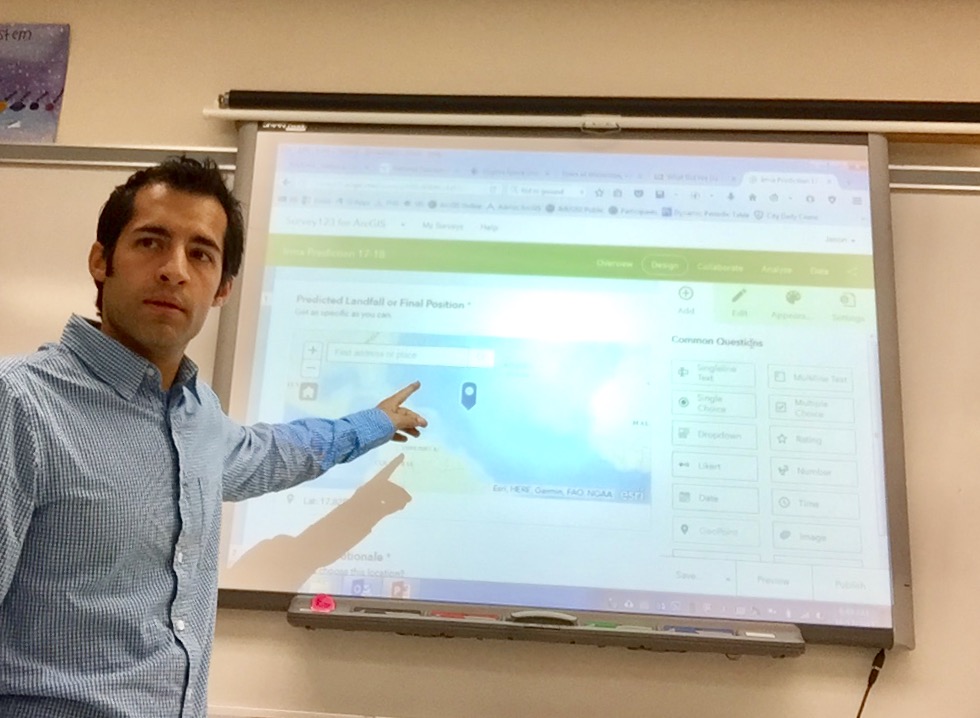- Home
- :
- All Communities
- :
- Industries
- :
- Education
- :
- Education Blog
- :
- Fun with GIS 222: Innovate to Educate
Fun with GIS 222: Innovate to Educate
- Subscribe to RSS Feed
- Mark as New
- Mark as Read
- Bookmark
- Subscribe
- Printer Friendly Page
Some teachers know, a month ahead of time, exactly what their class will cover, and even how it will work, minute-by-minute. Not Jason Smolinski, at Fairfax (VA) High School. His five sections of 12th grade GIS sometimes don't even get the same content from one period to the next. "I no longer provide written instructions ... Instead, we do a brief reading at the start of class. I then demo a new concept/tool/etc, have them work through a practice with me, and then give them an assignment for the second half of the class period. Since I no longer write instructions, I am free to change topics or examples, even at the last minute..."
As part of the Virginia Geospatial Semester, Smolinski teaches GIS to high school seniors, in a project-based style. The school uses a block schedule, so he gets 150 students for 90 minutes each, every other day. The scheduling and instructional style allow students to dive deeply into projects, and expand their exploration. But Smolinski still holds them accountable for learning: "Every few days, I encourage them to recall the last few lessons and write down the instructions or tips they need. I'll then allow them to use it on a formative assignment. When a summative assignment comes at the end of the quarter, they will not have access to these notes, as they should be familiar enough with the processes."

Inventing a strategy du jour might cause angst for some. Smolinski does have experience to draw on; he was a GIS analyst for several years, and so has a deep grasp of maps, data, analysis, and the mission of GIS users -- to understand complex situations more completely, in order to make good decisions, in constantly new situations. But, he adds, anyone could teach like this. Taking advantage of events that change by day or even by hour, he engages students with relevant, timely examples. "We do a lot of analysis. Find all schools within 10 miles of a nuclear power plant in this state. Analyze the landcover in hexagons. And, so far, we've done everything this year with ArcGIS Online, which lets us be more creative, share, use templates and the Web AppBuilder. From a data view, it's just much easier and more interesting to work with Online. We used ArcMap [for some projects] last year but we'll use ArcGIS Pro this year, so we can connect more powerfully with Online in the deep dives."
So, what do the students think after dancing around with new ideas, new tools, new data constantly, and only a vague idea of what might happen tomorrow? "Many of the kids said they didn't know computers all that well, but learned to think differently, and amazed themselves with what they could do. They don't get a lot of opportunity to think about a technology skill set, but GIS, with this project-based class, and the way we work, shows them 'Look what I can do that other kids can't!' This helps students grow in ways they can’t anticipate."
VGS mentor Kathryn Keranen says “Jason and some others are just so comfortable with technology, it’s seamless. He shows something on-screen, puts up three bullet points to guide them, and they go to work. They may be doing things a little bit their own way because of what they’ve learned before, but they are trying new things constantly, and come up with new ideas. They walk out knowing how to use the software to handle questions that don’t come with instructions.”
You must be a registered user to add a comment. If you've already registered, sign in. Otherwise, register and sign in.
-
Administration
80 -
Announcements
80 -
Career & Tech Ed
1 -
Curriculum-Learning Resources
259 -
Education Facilities
24 -
Events
72 -
GeoInquiries
1 -
Higher Education
598 -
Informal Education
281 -
Licensing Best Practices
93 -
National Geographic MapMaker
33 -
Pedagogy and Education Theory
226 -
Schools (K - 12)
282 -
Schools (K-12)
273 -
Spatial data
35 -
STEM
3 -
Students - Higher Education
246 -
Students - K-12 Schools
129 -
Success Stories
36 -
TeacherDesk
1 -
Tech Tips
121
- « Previous
- Next »